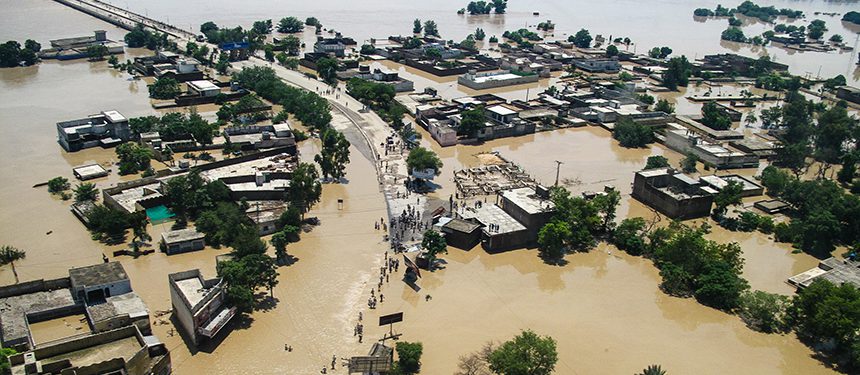What's happening: Flooding in Pakistan

What’s happening in Pakistan?
Since mid-June, Pakistan has been impacted by one of the most prolonged and widespread monsoon seasons. The government has declared that 81 out of 160 districts countrywide have been ‘Calamity Hit’, with Sindh, Balochistan Khyber Pakhtunkhwa being the worst affected. Balochistan has experienced 5.1 times its 30-year average rainfall, while Sindh has experienced 5.7 times its 30-year average rainfall.
Since 14th June, approximately 1,355 fatalities and 12,722 casualties have been reported, with significant infrastructural damage to houses, bridges and roads. The country estimates that a further 33 million people across 70% of the country are affected by residual flooding and landslides.
The flooding has caused significant damage to critical infrastructure across the affected provinces. Nationwide railway services have been suspended for weeks as some rail tracks have been damaged, and repair works have not been possible. Intermittent airport closures and flight delays have also been reported.
Flooding has also caused operational disruption at sanitation facilities, water treatment plants, electricity, schools, shops, markets and communication networks, and up to 50% of water systems countrywide are reportedly damaged. Widespread flooding and heavy rainfall led to internet outages in central and northern Pakistan. International humanitarian organisations have rapidly deployed flood disaster responses.
Why is the flooding in Pakistan so bad this season?
While floods are common during the monsoon season, record rainfall and a faster rate of melting glaciers have contributed to unprecedented flooding this year. Pakistan has more than 3,000 glacial lakes, of which 33 are prone to glacial lake outburst flooding. Intense heatwaves from March to May increased glacial melt in the Himalayas, releasing snow and ice melt into the river basins. The increase in dam-building construction throughout the country also worsened the effects of flooding due to overflowing from pockets of water caused by the dams.
July to August also saw an increased rainfall surge, resulting in high flood risks along the Indus River, especially between Taunsa in Punjab and Kotri in Sindh. The authorities announced that the existing water drainage systems and pumps are insufficient to mitigate incoming flood levels, while disaster-resilient infrastructures remain inadequate. Efforts to breach the Manchar Lake to lower water levels to prevent overflow has impacted at least 100,000 households.
Flooding in Pakistan is unlikely to improve in the short term
We anticipate that residual disruption will persist, as the monsoon is forecast until the end of September, alongside further damage to infrastructure and critical services. However, officials expect water levels to start receding in September.
While Pakistan has already deployed its military to launch search and rescue operations, many of these operations have been limited by flood levels and damage to transport infrastructure such as roads, bridges and railways. While rescue operations continue to be hindered, an uptick in casualties and fatalities is expected.
There will be intermittent travel disruption to flights, trains and major highways across the worst affected areas. Sporadic, low-level localised civil unrest may occur due to growing dissatisfaction with the government’s management of the floods.
There are concerns about food scarcity and a significant operational impact on Pakistan’s healthcare system. Acute food shortages have occurred due to the amount of damage inflicted on livestock, agrarian land, transport networks, logistic facilities, warehouses and shops. The country has reported inflation in commodities before June. Many relief shelters have reported clean water shortages and a lack of adequate sanitation facilities. The short supply of medicinal products is exacerbated by damage done to storage facilities and transport infrastructures. The government has announced a price hike for petroleum from September, which would disproportionately hit vulnerable groups dependent on kerosene.
Cases of diarrhoea and waterborne diseases, respiratory infection, and skin diseases have already been reported
There are concerns regarding outbreaks of dengue and malaria, waterborne diseases such as cholera, and respiratory infections as the situation prolongs, particularly in temporary relief shelters which are housing over 630,000 displaced persons and are reporting overcrowding conditions. Transportation to and from hospitals has also been impacted due to widespread infrastructure damage. Pakistan’s already poorly equipped healthcare infrastructure has been severely undermined as 888 clinics and hospitals have been destroyed by floods. Medical camps have reported an increase in skin and waterborne diseases. The floods have also impeded the country’s ability to respond to other pre-existing diseases such as measles and polio.
Advice for travellers
- Personnel planning to travel to affected areas should anticipate disruption associated with clean-up operations in the coming weeks.
- Journey management planning should minimise time spent on unpaved roads owing to the likelihood of damage being caused by flooding. Vehicles should be assessed for driving in poor conditions before departure – ideally with capacity for four-wheel drive.
- Security managers should ensure that personnel undertaking travel to coastal areas have anticipated likely disruption, including to telecommunication networks, and ensure that adequate stocks of food and water are carried.
- Refrain from crossing floodwaters, even if shallow, owing to the risk of strong undercurrents or submerged debris.
- Monitor the Pakistan Meteorological Department (PMD) website (https://www.pmd.gov.pk/en/) and National Disaster Management Agency (NDMA) website (http://cms.ndma.gov.pk/) for updates, as well as the Healix Travel Oracle app.
- Ensure that personnel has access to clean water, medical prescriptions and essential supplies that will last for at least 72 hours while in-country.


